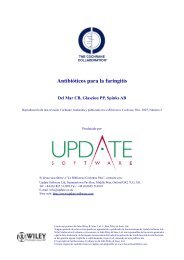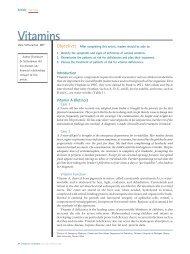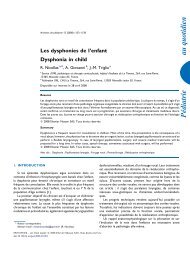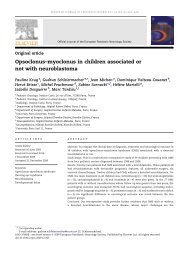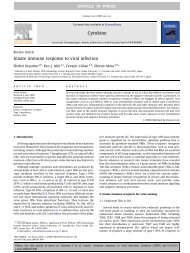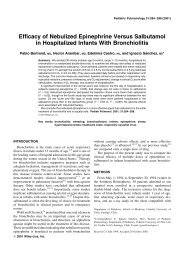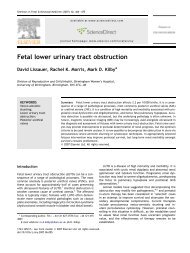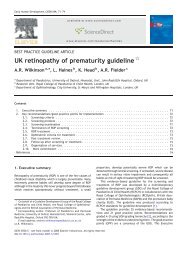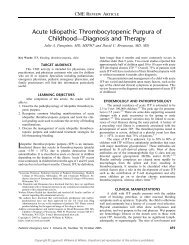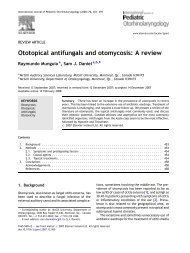Mini Review - sepeap
Mini Review - sepeap
Mini Review - sepeap
You also want an ePaper? Increase the reach of your titles
YUMPU automatically turns print PDFs into web optimized ePapers that Google loves.
358 Nader: Adrenarche And Polycystic Ovary Syndrome<br />
animals, conception is timed to ensure that birth takes<br />
place in a season when food and climatic conditions<br />
are appropriate. 79 Women affected by the Dutch famine<br />
of 1944e45 at ages 3e13 years had a 1.9-fold<br />
higher risk of having fewer than the desired number<br />
of children in their lifetime. 80<br />
Unfortunately, in the western hemisphere, where<br />
the food supply is plentiful, there is maladaptation.<br />
This may be exacerbated by an adverse intrauterine<br />
environment followed by excess catch-up growth, by<br />
genetic insulin resistance, often compounded by obesity<br />
or by a thrifty genotype. 78 Under such circumstances,<br />
early and excessive production of androgens<br />
from the adrenals promotes growth, development,<br />
and bone maturation, and leads to excessive LHinduced<br />
ovarian androgen production. These events<br />
hasten gonadarche but hinder full gonadal maturation<br />
and the establishment of ovulatory cycles. This state<br />
of hyperandrogenism, anovulation, and cystic ovarian<br />
morphology is what we call PCOS.<br />
Challenges and Future Directions<br />
We need to move away from the concept of a single<br />
path to PCOS toward a broader view of its pathogenesis,<br />
encompassing multiple derangements. What we<br />
call PCOS is likely to be a diverse group of disorders<br />
with similar clinical manifestations and shared biochemical<br />
features. There will be commonalities and<br />
differences in these different entities. Should they<br />
all be called PCOS? For example, non-classic or<br />
late-onset congenital adrenal hyperplasia is really<br />
a form of PCOS, with clinical manifestations that are<br />
virtually identical. The partial deficiency of the 21-<br />
hydroxylase enzyme responsible for the commonest<br />
form of this disorder does not manifest itself clinically<br />
during early childhood. As the zona reticularis develops<br />
and is stimulated, excessive amounts of adrenal<br />
androgens are produced. 81 This androgen excess<br />
not only leads to hirsutism, but hinders the establishment<br />
of normal ovulatory cycles. We do not call it<br />
PCOS because we understand its pathophysiology<br />
and genetics and categorize it as a separate entity.<br />
Thus it would seem that our task should begin by<br />
cataloging androgen excess disorders, determining<br />
their associations, biochemical pathways, and genetics.<br />
Only by doing so can we rationally approach prevention<br />
and treatment of this common reproductive<br />
problem and its many consequences.<br />
References<br />
1. Stein IF, Levanthal M: Amenorrhea associated with bilateral<br />
polycystic ovaries. Am J Obstet Gynecol 1935; 29:181<br />
2. Ehrmann DA: Polycystic ovary syndrome. N Engl J Med<br />
2005; 352:1223<br />
3. Carmina E: The spectrum of androgen excess disorders.<br />
Fertil Steril 2006; 85:1582<br />
4. Diamanti-Kandarakis E, Kouli CR, Bergiele AT, et al: A<br />
survey of the polycystic ovary syndrome in the Greek island<br />
of Lesbos: hormonal and metabolic profiles. J Clin<br />
Endocrinol Metab 1999; 84:4006<br />
5. Sam S, Dunaif A: Polycystic ovary syndrome: syndrome<br />
XX? Trends Endocrinol Metab 2003; 14:365<br />
6. Ibanez L, Dimartino-Nardi J, Potau N, et al: Premature<br />
adrenarche-normal variant or forerunner of adult disease?<br />
Endocr Rev 2000; 21:671<br />
7. Ibanez L, Ong K, Dunger DB, et al: Early development of<br />
adiposity and insulin resistance after catch-up weight gain<br />
in small-for-gestational-age children. J Clin Endocrinol<br />
Metab 2006; 91:2153<br />
8. Ibanez L, Valls C, Ong K, et al: Metformin therapy during<br />
puberty delays menarche prolongs pubertal growth and<br />
augments adult height: A randomized trial of low-birthweight<br />
girls with early-normal onset of puberty. J Clin<br />
Endocrinol Metab 2006; 91:2068<br />
9. Rotterdam ESHRE/ASRM-sponsored PCOS consensus<br />
workshop group: Revised 2003 consensus on diagnostic<br />
criteria and long-term health risks related to polycystic<br />
ovary syndrome (PCOS). Hum Reprod 2004; 19:41<br />
10. Azziz R: Diagnostic criteria for polycystic ovary syndrome:<br />
A reappraisal. Fertil Steril 2005; 83:1343<br />
11. Azziz R, Camina A, Dewailly D, et al: Position statement:<br />
Criteria for defining polycystic ovary syndrome as a<br />
predominantly hyperandrogenic syndrome: An Androgen<br />
Excess Society Guideline. J Clin Endocrinol Metab 2006;<br />
91:4237<br />
12. Terasawa EI, Fernandez DL: Neurobiological mechanisms<br />
of the onset of puberty in primates. Endocr Rev 2001; 22:<br />
111<br />
13. Reiter EO, Grumbach MM: Neuroendocrine control mechanisms<br />
and the onset of puberty. Annu Rev Physiol 1982;<br />
44:595<br />
14. Rapisarda JJ, Bergman KS, Steiner RA, et al: Response to<br />
estradiol inhibition of tonic luteinizing hormone secretion<br />
decreases during the final stage of puberty in the rhesus<br />
monkey. Endocrinology 1983; 112:1172<br />
15. Legro RS, Lin HM, Demers LM, et al: Rapid maturation<br />
of the reproductive axis during perimenarche independent<br />
of body composition. J Clin Endocrinol Metab 2000; 85:<br />
1021<br />
16. Filicori M, Santoro N, Merriam GR, et al: Characterization<br />
of the physiologic pattern of episodic gonadotropin secretion<br />
throughout the human menstrual cycle. J Clin Endocrinol<br />
Metab 1986; 62:1136<br />
17. Gross KM, Matsumoto AM, Bremner WJ: Differential<br />
control of luteinizing hormone and follicle stimulating<br />
hormone secretion by luteinizing hormone releasing hormone<br />
pulse frequency in man. J Clin Endocrinol Metab<br />
1987; 64:675<br />
18. Hoff JD, Quigley ME, Yen SS: Hormonal dynamics at<br />
mid-cycle: a reevaluation. J Clin Endocrinol Metab<br />
1983; 57:792<br />
19. Adams JM, Taylor AE, Schoenfeld DA, et al: The midcycle<br />
gonadotropin surge in normal women occurs in the<br />
face of an unchanging gonadotropin-releasing hormone<br />
pulse frequency. J Clin Endocrinol Metab 1994; 79:858




